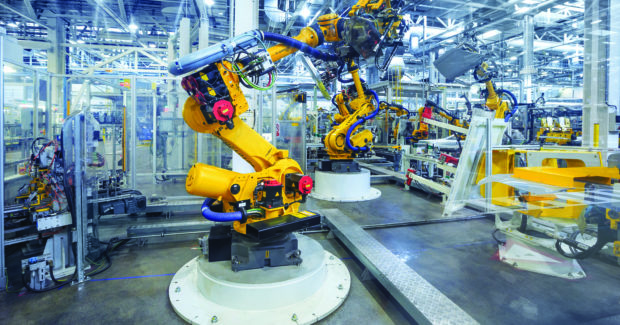The Day the Robots Take Control: Part One
Is the robot revolution really such a bad thing? As automation and robotics sweep through manufacturing, Smart Factories driven by digital information are slowly emerging as an ultra-lean answer to the skilled labor shortage and other competitive issues.
Posted: February 15, 2019
An inflection point is a decisive moment in the course of business that marks the start of significant change. The skilled labor shortage, combined with increasingly adaptive, affordable and often superior capabilities in automation and robotics, is pushing the metalworking business toward an inflection point in advanced technologies, a period of disruption where manufacturers must respond effectively or face competitive deterioration – and they are definitely responding. Once treated as science fiction in a time gone by, automation and robotics are now sweeping across shop floor operations as traditional plants slowly evolve into Smart Factories that get their biggest boosts in productivity from digital information that is creating new ways to improve the bottom line by addressing competitive issues ranging from the lack of skilled labor to rising material costs due to tariff disputes.
Embracing the Robotic Revolution
U.S. manufacturers cannot ignore the growing implications of failing to adopt modern robotics and automated technologies. Rather than fearing the rise of the robot, Americans must further embrace the technology or risk getting left behind in the global manufacturing race.
How Robotics Can Offset Trade Cost Hikes
To offset the rising cost of metals and avoid hurting their bottom lines, many shops are turning to robotics for repetitive-based processes to help optimize their workforce productivity through precision and consistency.
For evidence of how the robotic revolution is sweeping through the metalworking industry, take a look at some of the latest innovations that have recently been introduced:
Robot Inspection: The Future of Flexible Manufacturing
For automated inspection of manufactured parts in shorter cycle times, the Robot Inspection System from ABB / NUB3D raises quality and reduces the risk of errors by rapidly recording and comparing highly detailed geometric and surface data with digital CAD models.
Robotic Grinding, Deburring and Polishing Cell
The SmartForce robotic cell from ABCO Automation uses human-touch capabilities to grind, deburr, or polish in any orientation, even over contours, with consistent, quality results that remove employees from working in manual machining processes under gritty, taxing, and hazardous conditions.
Robot Performance Measurement and Calibration
To increase robot positional accuracy up to 12X in machining, drilling, grinding, welding, cutting, inspection, deburring and 3D printing operations, the Robot Measurement Solution from API verifies and calibrates robot accuracy to the ISO 9283 standard in a completely automated run-time.
How to Give Robotic Grinding and Polishing Processes a Sense of Touch
Ideal for robotic assembly, grinding, and polishing operations, the Axia80 F/T sensor from ATI obtains feedback from force and torque loads as a process is occurring to make robotic and automated processes more acute and responsive.
Robots in Laser Seam Stepper Automated Work Cells
Laser Seam Stepping automated work cells from Coldwater Machine can replace resistance spot welding operations and are well suited to automotive body-in-white applications and anywhere there is a need for low heat input and good surface finish.
Next Generation Robot Machine Tending
The modular MATRIS robot system from DMG MORI can be paired with turning centers, machining centers and 5-axis machines for flexible machine tending of high precision medical and automotive applications, as well as general machining operations.
Doing Tasks with Robots That Were Not Possible Before
The intuitive Force Guide integrated force control system from Epson Robots enables robots to perform grinding, polishing, part insertion, screw driving and other high precision operations that require high performance motion guidance.
Intelligent Multi-Arm Robot Welding Systems
Multi-Arm welding systems from FANUC connect arc welding robots and a material handling robot to a seam tracking sensor that tracks and inspects different welds with coordinated motion between the welding and material handling robots.
Flexible Robotic Precision Finishing Systems
Robotic finishing systems from Fastems eliminate variations that are common in hand-finishing operations, maximize the output of consistently precise parts, and relieve employees of tedious and tiring hand finishing activities.
Smart Robotic Part Sorting and Arranging Made Easy
SmartWing robots from Fuji make workpiece sorting, accurate long screw placing, loose part sorting and arranging, and dual robot cooperation for inserting and tightening screws remarkably easy and efficient with accessible automation that virtually eliminates teaching.











